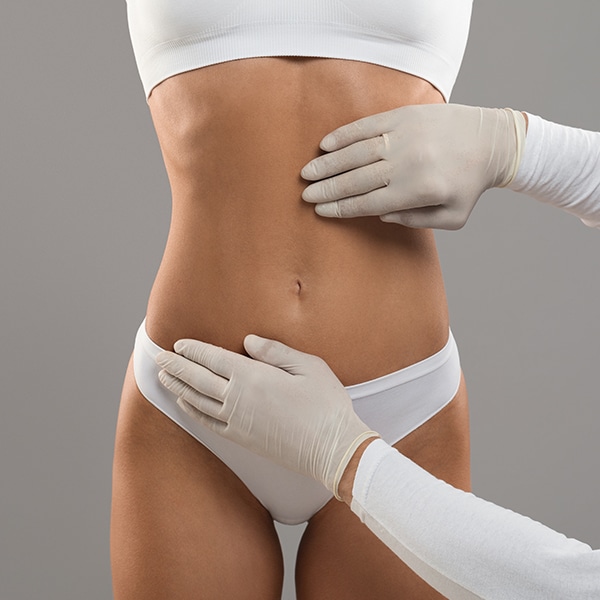Tummy Tuck
A tummy tuck, also known as abdominoplasty, is a cosmetic surgery procedure used to remove excess skin and fat from the abdomen and tighten the abdominal wall muscles. The tummy tuck was first performed in the early 1900s and has become very popular in recent years.
If you’re looking for a tummy tuck in Bakersfield, call (661) 808-4070 to book an appointment or fill out the contact form. Dr. Freeman can answer any questions you may have about the procedure and if it’s right for you.

Why get a Tummy Tuck?
We all want a flat, toned midsection, but even with diet and exercise, this might not be possible. Even people who are at a healthy weight may have loose skin in the abdominal area. Reasons for this may include:
- Major fluctuations in weight
- Aging
- Pregnancy
- Heredity
There are many reasons why people choose to get this procedure. Some men or women have genetic conditions that cause excess skin or fat in the abdominal area, and others have loose abdominal muscles that need to be tightened. The tummy tuck is often sought by women who have had multiple pregnancies or lost a significant amount of weight.
What it Can’t Fix
A tummy tuck is not a weight-loss surgery and should not be used as such. The ideal candidate for this procedure is someone who is at a stable weight, is in good physical and mental health, and wants to remove excess skin or fat in the abdominal area or tighten loose abdominal muscles. If you are considering surgery, it is important to have realistic expectations about the results of your surgery. A tummy tuck cannot correct stretch marks, although they may be removed or greatly reduced if they are located on the portions of skin that will be excised during surgery.
Types of Procedures
Different types of procedures can be performed, depending on the patient’s needs.
- Complete abdominoplasty: An incision is made from hip bone to hip bone and around the navel. The skin is lifted all the way up to the ribs, allowing the surgeon to access and tighten the abdominal muscles. Drainage tubes may be placed under the skin.
- Partial abdominoplasty: Also known as a mini-abdominoplasty, this procedure is used when there is only a small amount of excess skin or fat in the lower abdomen. The incision for a partial tummy tuck is much smaller than for a complete tummy tuck and usually does not require an incision around the navel.
- Circumferential abdominoplasty: This procedure includes a lift of the buttocks and thighs. It can also be called a Belt Lipectomy and results in a scar that runs the circumference of the body. It is often used for patients who have undergone massive weight loss and have a large amount of excess skin in these areas.
- Panniculectomy: This procedure removes a pannus, an apron of excess skin and fat that hangs over the genitalia and down to the thighs. It is often seen in massive weight loss patients. This surgery does not involve tightening the abdominal muscles and usually only leaves a scar along the bikini line.
After the Surgery
After a tummy tuck, you will be wrapped in an elastic compression garment or ace bandage. This will help to support your abdomen and lower back as you heal. You will also have small drains placed under your skin to remove any excess fluid that might build up. These drains are usually removed within a week or two.
You will likely feel some pain and discomfort after surgery, which can be controlled with pain medication. You should expect to take it easy for at least the first week or two after surgery and avoid any strenuous activity or heavy lifting. It is important to walk around as much as possible to reduce the risk of developing blood clots.
Most people can return to work within 2-3 weeks, although this will depend on the type of tummy tuck and your individual healing process. You will need to avoid strenuous exercise for 4-6 weeks after surgery.
The final results of a tummy tuck will be visible after the swelling and bruising have dissipated, which can take months. The scars will continue to fade over time. You should protect your skin from the sun to prevent permanent discoloration of the scars. Maintaining a healthy diet and regular exercise are essential for success.
Benefits of Abdominoplasty
There are many benefits to having a tummy tuck, which is why patients choose to have the surgery even though it is a major operation. Some of the benefits may include:
- A flatter, more toned stomach
- A more defined waistline
- Elimination or reduction of stretch marks
- Improved self-esteem and body image
- Improved clothing fit
Get The Results You Want
If you are considering having a tummy tuck, it is important to consult with a board-certified plastic surgeon to discuss your goals and expectations.
The surgeon will perform a physical exam and assess your medical history to determine if you are a good candidate for surgery. They will also discuss the different types of tummy tucks available and help you choose the best option for you.
It is also important to ask questions during your consultation so that you feel comfortable with the surgeon and the procedure.
Some questions you may want to ask include:
- How many tummy tucks have you performed?
- Where will my incisions be located?
- What type of tummy tuck do you recommend for me?
- What are the risks and complications associated with a tummy tuck?
- How long will the surgery take?
- What is the recovery time for a tummy tuck?
- When can I expect to see results?
Potential Complications
As with any major surgery, there are risks involved. These risks may include:
- Anesthesia risks: As with any surgery that requires anesthesia, there are risks associated with the anesthesia itself. These risks may include but are not limited to allergic reaction, heart attack, stroke, lung problems, and kidney failure.
- Infection: There is always a risk of infection with any surgery. The incisions made during a tummy tuck surgery provide an entry point for bacteria. To avoid infection, follow your surgeons post-operative instructions carefully.
- Wound healing: The wound can open, or dehisce, and supportive wound care may be needed,
- Bleeding: Although it is not common, excessive bleeding can occur during surgery.
- Skin loss: In rare cases, the skin may die due to a lack of blood flow.
- Numbness: There is a risk of numbness or changes in skin sensation on the stomach, thighs, or groin area. This is usually temporary but may be permanent in rare cases.
- Scarring: There will be scars left after tummy tuck surgery. The size and placement of the scars will depend on the type of tummy tuck performed.
- Deep vein thrombosis (DVT): DVT is a condition that occurs when a blood clot forms in the veins, usually in the leg. This can be a serious condition as the clot could break off and travel to the lungs, causing a pulmonary embolism.

Tummy Tuck in Bakersfield
A tummy tuck can be a life-changing surgery and can help to improve your self-esteem and body image. If you are considering a tummy tuck in Bakersfield, Dr. Freeman and his team would be happy to answer any questions you have about this procedure. Dr. Freeman is a board-certified plastic surgeon who can help you get the results you want!
Call (661) 808-4070 to book an appointment or fill out the contact form.
